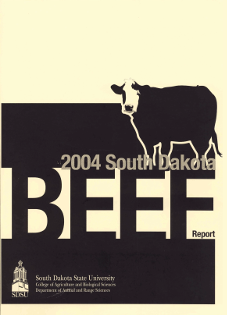Document Type
Report
Report Number
2004-5
Publication Date
2004
Summary
A study was conducted to determine the effects of implants and transportation on the metabolic status of feedlot steers. Steers (n = 28) were sorted by body weight, allocated into light or heavy blocks, and randomly assigned to one of two treatments. Treatments included non-implanted controls (CON) and steers implanted with Synovex Plus 70 d prior to harvest (IMP). Jugular blood and muscle biopsy samples (longissimus dorsi (LD) and semimembranosis (SM)) were collected 70 d post-implant, prior to transit. Steers were transported to Schuyler, NE, where blood and biopsy sampling was repeated. After harvest, carcass data were collected and muscle samples were taken from the LD, SM, Psoas Major (PM), and Illiacus (IL) muscles. Implanting increased (P < 0.05) estradiol levels and improved live animal performance. Carcass weight and rib eye area were increased (P < 0.05) in implanted steers. No dark cutters were found in either treatment. Pre-transit insulin/glucagon ratio and muscle glycogen levels did not differ (P > 0.10) between treatments. Non-esterified fatty acid (NEFA) levels were reduced (P < 0.05) in implanted steers pre-transit. Transit increased (P < 0.05) NEFA levels, but had no effect (P > 0.10) on insulin/glucagon ratio or muscle glycogen levels. Implanting did not affect (P > 0.10) insulin/glucagon ratio, NEFA, or LD glycogen levels post-transit. Implanted steers had lower (P < 0.05) glycogen levels in the SM than did non-implanted steers post-transit. Weight block affected (P < 0.05) insulin and insulin/glucagon ratio levels, with steers in the light block having greater levels of each. Muscle pH and objective color (L*, a*, b*) of the LD were not biologically different between treatments. Implanted steers had greater (P < 0.05) glycolytic potential values in the LD, and tended (P < 0.10) to have higher L* values in the PM. Implanting increased (P < 0.05) shear force of the LD. These data indicate that although implants affect bovine metabolism, other factors are necessary to cause a sufficient reduction in muscle glycogen and to produce a dark cutting carcass.
Number of Pages
4
Format
application/pdf
Language
en
Publisher
South Dakota State University
Rights
Copyright © 2004 South Dakota State University
Recommended Citation
Patterson, Hubert H.; Johnson, Patricia S.; Epperson, Wiliam B.; and Haigh, R. D., "Effect of Total Dissolved Solids and Sulfates in Drinking Water for Growing Steers" (2004). South Dakota Beef Report, 2004. 6.
https://openprairie.sdstate.edu/sd_beefreport_2004/6

